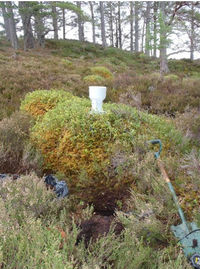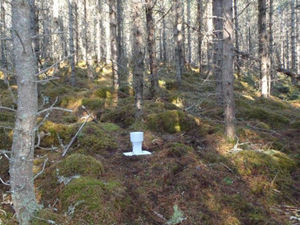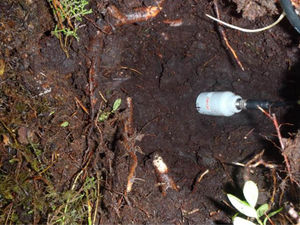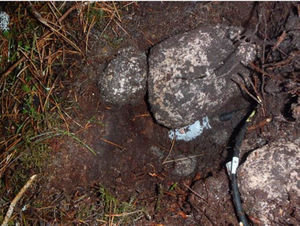OR/17/014 Investigation of Old Forest and 40 year Plantation sites
| Archer, N A L, Everest, J. 2017. Final Report: Emergent Forest dynamics and Natural Flood Management. British Geological Survey Internal Report, OR/17/014. |
Installation of soil moisture and rainfall measurement in representative old forest and plantation sites
The British Geological Survey had Delta-T Devices (Cambridge, UK) soil moisture sensors and a rain gauge, which enabled the possibility to instrument the two chosen areas, at the end of March 2015. Sensor positions for each site are shown in Figures 7 and 30.
An extra rain guage was bought from the funds available from this project, so that each site could be instrumented with a raingauge and four soil moisture sensors installed between 0.25 and 0.35 m soil depth at each site. The position of soil moisture sensors in the soil profiles and layout of instrumentation are shown in Figures 16 and 17 respectively. Sensors were placed near the soil/sand and gravel interface, unless peat depths exceeded 0.4 m, as shown for sensors 1 and 8 (Figure 16). Figure 17 shows the layout of the sensors within the two sites, where two sensors were installed in depressions (grey areas in figure 17) and two sensors were located in ridges (white areas shown in figure 17) and were installed in the direction of the slope. The sensors measured every 15 min. from 27th March 2015 to 8th September 2016. Unfortunately, in the plantation site, due to faulty batteries, the soil sensors in the plantation stopped logging during the winter from 30th October to 28th March 2016. A very dry period during October 2016, was also not measured, as the soil sensors were uninstalled at the beginning of September 2016.
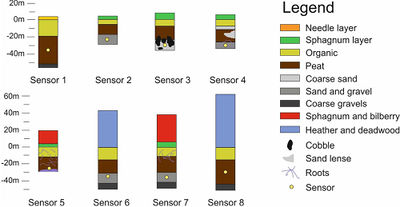
The layout of soil sensors were located in this way to provide some understanding of soil water infiltration and redistribution within the soil profile, to address the following questions:
- How much rainfall enters the forest canopy of both areas?
- Is there sub-surface flow occurring downslope?
- Do the depressions have greater soil wetness throughout the year in comparison to ridges?
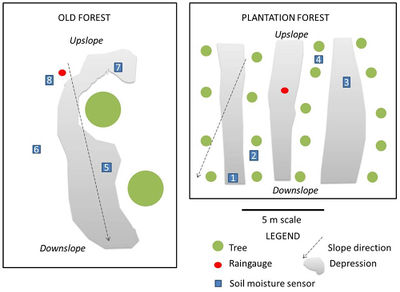
Results of soil moisture sensors
Soil water contents measured at eight points from 27th March 2015 to 8th September 2016 are shown in Figures 18 and 19. It is unfortunate that soil moisture was not recorded for most of the winter in the plantation site. However, overall, the soil sensors in the plantation are all very responsive to rainfall, particularly for sensors 2 to 4 positioned in sand and gravel layers (Figure 16), these sensors tend to respond to peak rainfall within 20 hours. Here the soil profiles wet-up quickly in response to high intensity or long duration rainfall and then drain quickly, creating dynamic fluctuating soil water curves. Sensor 1 is located in peat and sensor 4 is located in a mixed sandy peat, and they have consistently larger soil water content throughout the year. Sensor 1 is not as responsive to rainfall as the other sensors. In the Old Forest, each sensor has a different dynamic in relationship to rainfall events. Only Sensor 6, located in sand and gravel, is very responsive to rainfall. This sensor quickly wets-up even during relatively low magnitude rainfall events and rapidly drains during drier intervals, creating a similar fluctuating curve to the curves in the plantation for Sensors 2 to 4.
In the Old Forest, Sensors 5, 7 and 8 do not respond to high intensity rainfall like the other sensors. All three sensors are below heather, bilberry and sphagnum mounds, but are all placed in different substrate. Sensor 5 is placed in organic soil above a mature tree root (Figure 16), which belongs to a 250 year old Scots pine and has the largest variation of soil water content in comparison to all other sensors (Figure 24). Considering the change in volumetric soil water content from 0.4 to 1 m3 m-3 means that the soil sensor becomes fully saturated, suggesting that there is preferential flow, which is typical of the occurrence of root channels. The gradual reduction of soil water content during the summer even when there is rainfall also suggests active evapotranspiration taking place. Sensor 7 has a similar pattern to sensor 5, although the range of volumetric soil water content change remains narrower (from 0.38 to 0.62). Finally, Sensor 8 remains almost consistently at saturation throughout the year and this is the only sensor in peat below a sphagnum and bilberry mound.
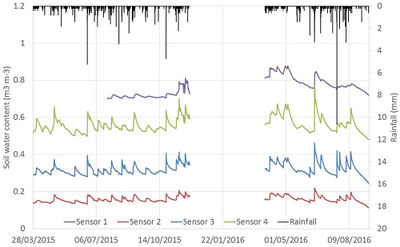
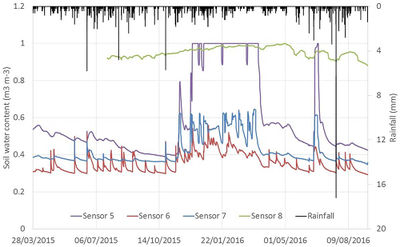
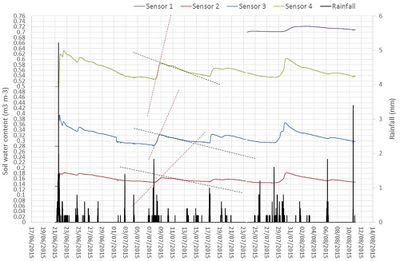
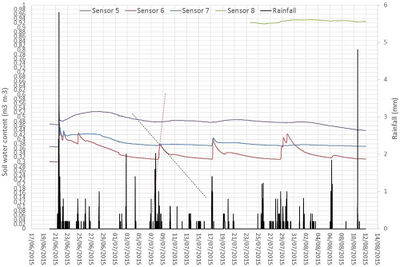
Looking more closely at the wetting peaks of sensors 2, 3 and 4 in the plantation, the peaks occur approximately at the same time with the onset of rainfall; i.e. when rainfall is >1 mm, or there is a series of low (0.8 mm), but consistent rainfall. Once the soil begins to wet-up there is a rapid rate of water infiltration to peak water contents, ranging from infiltration rates of 2 mm/day (Sensor 2) to 10 mm/day (Sensor 4). Drainage and water loss are slower from 0.4 (Sensor 2) to 0.8 mm/day (Sensor 4). In the Old Forest site, the rate of water gain and loss in the soil profile at Sensor 6 however is higher (e.g. water infiltration 18 mm/day and drainage and evaporation/ET 3 mm/day). Figure 26 shows that Sensors 5 and 7 are relatively unresponsive to rainfall.
Rainfall between the two sites
Because the rain gauges were not heated during the winter, snow built-up in the rain gauge funnels. As the snow melted, the melt gave an impression of rainfall. This however was useful to understand infiltration rates of water, irrespective of whether the source of the water was rainfall or snowfall.
Results of rain gauge measurements between the plantation and old forest sites
Unfortunately, there was a technical fault with the Plantation datalogger, causing a loss of three months data during the winter. Therefore to be able to compare the rainfall quantity on both sites, the missing data of the plantation site was also removed from the Old Forest site and then cumulated. The resulting cumulated rainfall for the two sites is shown in Figure 23, showing cumulatively that the Old Forest received 134 mm more rainfall at ground level during the measurement period than the Plantation site.
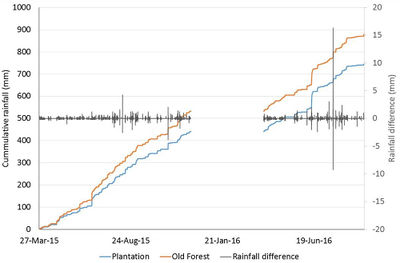
Maximum 15 min. rainfall intensity was 5.2 mm in the Plantation site and during the interval when the Plantation rain gauge was not working, the Old Forest recorded 17.2 mm during the winter.
Measurement of soil depth and vegetation height in old forest and plantation sites
A 20 m x 15 m grid was delineated within each site area and divided on the ground into smaller 2.5 m grids. At each intersecting 2.5 m point, an avalanche pole was used to measure soil depth and vegetation height. Soil depth was considered to be from the level of the ground to the point where the avalanche pole strikes a gravel layer. Understorey vegetation height was measured to be from the ground to the top of vegetation branches.
Results of soil depth and understorey vegetation height between old forest and plantation sites
The Anderson-Darling test for a normal frequency distribution showed that the data for soil and vegetation depth were not normally distributed. This was partly due to outliers within the data (as shown in Figure 22). The non-parametric Wilcoxon-Mann-Whitney was therefore used to compare differences between soil and vegetation between the Old Forest and plantation sites. This test showed that soil depth and vegetation height were significantly greater in the Old Forest site than the plantation (p = 0.0001 for soil depth and p < 0.0001 for vegetation height). A box-plot showing the spread of data are shown in Figure 23.
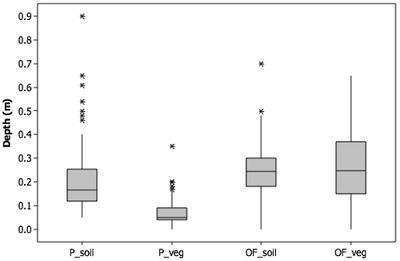
Measurement of field saturated hydraulic conductivity within adjacent old forest and plantation forests
A Guelph constant head well permeameter (Reynolds, et al., 1983[1]) was used to measure the field saturated hydraulic conductivity (Kfs) and hydrostatic pressure potential (φm) within the Old forest and the plantation forest sites (figure 24). Auger holes were generally augered to the gravel layer, which ranged between soil depths of 13 to 39 cm. Kfs was measured at the soil/gravel interface using the Guelph permeameter procedure. For each augered hole two infiltration rates (cm/min) were measured, one at a constant head of 5 cm and the other at 10 cm. Since the double-head permeameter method estimated negative Kfs and φm values for some of the augered holes, the single head method was preferred. Therefore the Kfs and φm estimated for the constant heads of 5 and 10 cm were averaged to provide average Kfs and φm values for each auger hole. Overall, a total of sixty auger holes were measured in the plantation and Old Forest sites from May to October 2016.
In the plantation, the holes were augered in either drainage lines/depressions or within tree planted ‘mounds’, following the pattern trees in which they had been planted. As shown in Figure 25, the drainage lines and planted trees changed direction depending on slope angle. Because of the glacial debris in the Cairngorms, boulders exist within the moraine systems, but in the plantation site, these boulders seemed to have been redistributed to the ground surface and repositioned along edges of drains, when the land had been drained for tree-planting. Presently, these boulders are thinly covered by sphagnum and sometimes blaeberry.
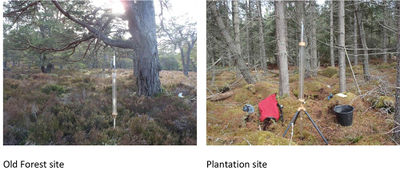
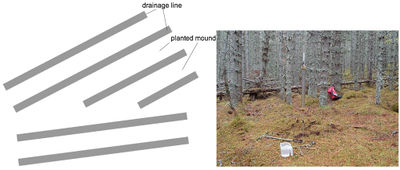
In the Old Forest trees were distributed depending on natural regeneration. There was a complex system of vegetation mounds under the expansive tree canopy where heather and sphagnum dominated or bearberry and blaeberry dominated with sphagnum. In some cases these vegetation mounds covered boulders that were part of the moraine system. Guelph permeameter measurements in the Old Forest therefore were taken within the natural pattern of depressions and vegetation mounds, as shown in Figure 26.
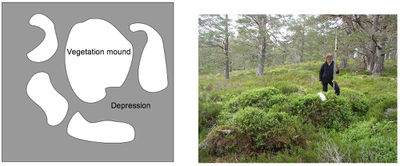
Results for field saturated hydraulic conductivity (Kfs)
Hydraulic conductivity is a highly variable soil property, where even samples taken within centimetres of each other can vary 10-fold or more (Soil Survey Division Staff, (1993). Because Kfs and φm are log normally distributed properties, the average Kfs and φm values (described in Table 3) were transformed using a log normal function and are displayed in Figures 27 and 28.
| Plantation | Old Forest | |||
| Kfs (cm/min) | Φm (cm2/min) | Kfs (cm/min) | Φm (cm2/min) | |
| Number of values | 30 | 30 | 31 | 31 |
| Mean | 0.399 | 0.0318 | 0.723 | 0.0405 |
| Mean standard error | 0.104 | 0.0076 | 0.240 | 0.0134 |
| Standard deviation | 0.567 | 0.0417 | 1.338 | 0.0746 |
| Minimum | 0.002135 | 0.0011 | 4.08251E-05 | 1.8905E-06 |
| Lower quartile | 0.058 | 0.0036 | 0.017 | 0.0009 |
| Median | 0.135 | 0.0110 | 0.057 | 0.0041 |
| Upper quartile | 0.683 | 0.0392 | 0.764 | 0.3540 |
| Maximum | 2.390 | 0.1709 | 4.801 | 0.2752 |
'
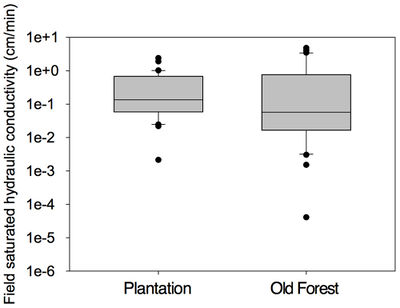
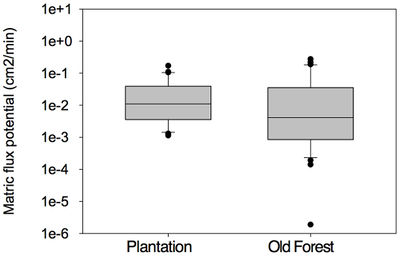
The t-test and ANOVA assume that the data is normally distributed and the variances of the two samples are homogenous. Although the logged data are normally distributed, the variances of Kfs and φm between the Plantation and Old Forest sites are significantly different (Levene’s test, p =0.041 and p=0.013 respectively). Therefore, the Mann-Whitney U test was used to establish whether there were significant differences in saturated hydraulic conductivity between the Plantation and Old Forest sites. It was found that Kfs medians were not significantly higher (p<0.05) in the Plantation site than the Old Forest site (calculated at p = 0.1821), but was significantly different for φm (calculated p = 0.05).
Differences between log-transformed Kfs values measured in depressions and mounds for each site were found to be significantly larger in the vegetation mounds than the depression areas in the Old Forest site (p= 0.005), but were not significantly different in the plantation site (p=0.35). The raw Kfs values are shown in Figure 29.
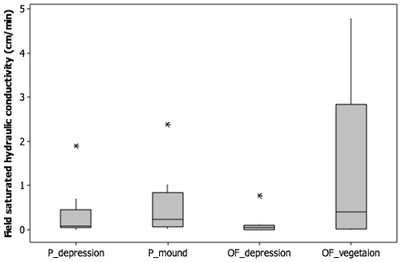
It must be noted that during October 2016, soils were particularly dry in the plantation, because there had been no rainfall for three weeks. At the bottom of the slope in the plantation the deeper peat soil had become dry and friable and Geulph permeameter measurements in this area, flowed out of the permeameter without resistance. To check for peat cracking, four auger holes were augered to 10 cm width to allow for inspection with a torch and allow for a hand to enter the hole and check if there were cracks. It was observed that all four auger holes had cracks to more than 1 cm to 0.4 m soil depth. The Guelph permeameter therefore could not be used in these dry peat soils, as the cracks in the peat caused preferential water flow, bypassing macropores and causing error to estimate Kfs. In the Old Forest site however, even though it had not rained in this area, the peat had not dried out, and no cracking was observed.
Slope direction and water movement
The dominant direction of water flow within each site is shown as yellow arrows in Figure 30. Main direction of flow is downslope towards the stream depressions, this is particularly relevant for the Plantation site. In the Old Forest site, some water flows into the site from the northern adjacent moraine.
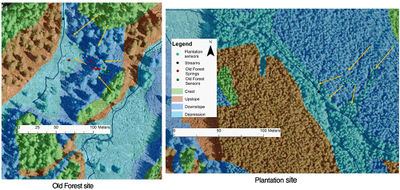
Reference
- ↑ Reynolds, W D, Elrick, D E, and Topp, G C. 1983. A re-examination of the constant head well permeameter method for measuring saturated hydraulic conductivity above the water table. Soil Science, 136 (4), 250–268.
